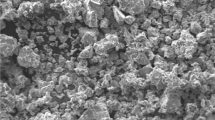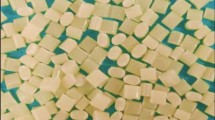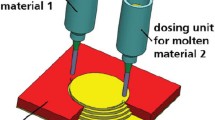Comprehensive research into the production of a ceramic-reinforced polymer material from highdensity polyethylene or polypropylene and β-Si3N4 powder was conducted. The incorporation of silicon nitride ceramic particles (5 and 10 vol.%) into the polymers to make polymer–ceramic filaments was studied step by step. High-quality polypropylene–ceramic filaments could be obtained at an extrusion temperature of 150°C with an extrusion speed of 20 cm/min and polyethylene–ceramic filaments at 160°C and 30 cm/min. Data on the shape and size distribution of Si3N4 particles were used to simulate the elementary volume of the filaments to determine the mechanical properties of the composites applying a 2D finite-element model. The reinforcement of the polypropylene/polyethylene-matrix material by 10 vol.% Si3N4 particles was not sufficient because the composite elastic modulus increased insignificantly and the critical strain decreased substantially to incorporate a greater volume of hard particles to improve the elastic modulus. To assess the quality of the polymer–ceramic filaments, parts of different shape (washer and auger) from reinforced and unreinforced filaments were designed and printed. The printed polymer–ceramic parts demonstrated a smooth surface and had no ledges or discontinuous areas. The mechanical (Vickers and Brinell hardness) and tribological (volume wear) properties of the materials were examined. Wear tests of the polyethylene–Si3N4 composite showed that its wear resistance tended to improve with increasing ceramic content of the filament. The low abrasive wear of the Si3N4-reinforced polypropylene/polyethylene material and the behavior of ceramic particles in contact with the indenter indicate that the composite has high fracture resistance in 3D printing.












Similar content being viewed by others
References
C. Zhangwei, L. Ziyong, L. Junjie, L. Chengbo, L. Changshi, F. Yuelong, L. Changyong, L. Yang, W. Pei, and H. Yi, “3D printing of ceramics: A review,” J. Eur. Ceram. Soc., 39, 661–687 (2019), https://doi.org/10.1016/j.jeurceramsoc.2018.11.013.
J. Gonzalez-Gutierrez, S. Cano, S. Schuschnigg, C. Kukla, J. Sapkota, and C. Holzer, “Additive manufacturing of metallic and ceramic components by the material extrusion of highly-filled polymers: A review and future perspectives,” Materials, 11, 1–36 (2018).
A.V. Ragulya and O.B. Zgalat-Lozynskyy, “Laser sintering of multilayer gradient materials,” in: Functional Gradient Materials and Surface Layers, Springer (2001), pp. 151–159.
A.V. Ragulya, V.P. Stetsenko, V.M. Vereshchak, V.P. Klimenko, and V.V. Skorokhod, “Selective laser sintering. II. Sintering multilayer refractory composites,” Powder Metall. Met. Ceram., 37, No. 11–12, 577–582 (1998).
Kwambio [Web resource], https://kwambio.com/.
Chervona Hvilya (xbeam3d) [Web resource], https://xbeam3d.com/about.
R. Anitha, S. Arunachalam, and P. Radhakrishnan, “Critical parameters influencing the quality of prototypes in fused deposition modelling,” J. Mater. Proc. Techol., 118, No. 1–3, 385–388 (2001).
M.K. Agarwala, V.R. Jamalabad, N.A. Langrana, A. Safari, P.J. Whalen, and S.C. Danforth, “Structural quality of parts processed by fused deposition,” Rapid Prototyping J., 2, No. 4, 4–19 (1996).
S.H. Masood and W.Q. Song, “Development of new metal/polymer materials for rapid tooling using fused deposition modelling,” Mater. Des., 25, 584–594 (2004).
O.A. Mohamed, S.H. Masood, and J.L. Bhowmik, “Optimization of fused deposition modeling process parameters: a review of current research and future prospects,” Adv. Manuf., 3, No. 1, 42–53 (2015).
P. Colombo, E. Bernardo, and G. Parcianello, “Multifunctional advanced ceramics from preceramic polymers and nano-sized active fillers,” J. Eur. Ceram. Soc., 33, No. 3, 453–469 (2013).
S.-H. Ahn, M. Montero, D. Odell, S. Roundy, and P.K. Wright, “Anisotropic material properties of fused deposition modeling ABS,” Rapid Prototyping J., 8, No. 4, 248–257 (2002).
S. Rangarajan, G. Qi, N. Venkataraman, A. Safari, and S. C. Danforth, “Powder processing, rheology, and mechanical properties of feedstock for fused deposition of Si3N4 ceramics,” J. Am. Ceram. Soc., 83, No. 7, 1663–1669 (2000).
X. Tian, T. Liu, C. Yang, Q. Wang, and D. Li, “Interface and performance of 3D printed continuous carbon fiber reinforced PLA composites,” Composites Part A, 88, 198–205 (2016).
P. K. Bajpai, I. Singh, and J. Madaan, “Tribological behavior of natural fiber reinforced PLA composites,” Wear, 297, No. 1–2, 829–840 (2013).
X. Wang, M. Jiang, Z. Zhou, J. Gou, and D. Hui, “3D printing of polymer matrix composites: a review and prospective,” Composites Part B, 110, 442–458 (2017).
A. Bellini, L. Shor, and S. I. Guceri, “New developments in fused deposition modeling of ceramics,” Rapid Prototyping J., 11, 214–220 (2005).
D. Nötzel, R. Eickhoff, and T. Hanemann, “Fused filament fabrication of small ceramic components,” Materials, 11, 1–10 (2018).
J. L. Leblanc, Filled Polymers: Science and Industrial Applications, CRC Press: Taylor & Francis Group (2010), p. 428.
L.W. McKeen, Fatigue and Tribological Properties of Plastics and Elastomers, 3rd ed., Elsevier Inc. (2016), p. 370.
B. Basu and M. Kalin, Tribology of Ceramics and Composites: A Materials Science Perspective, The American Ceramic Society, Wiley (2011), p. 522.
G.A. Petasyuk, “System analog method to identify and quantify the actual geometrical shape of projected abrasive powder grains,” Sverkhtverd. Mater., No. 4, 74–89 (2016).
G.A. Petasyuk, “System and criterial method of the identification and quantitative estimation of the geometrical shape of the abrasive powder grains projection,” Powder Technol., 264, 78–85 (2014).
V.S. Kim and V.V. Skachkov, Dispersion and Blending in Plastic Manufacturing and Processing [in Russian], Khimiya, Moscow (1988), p. 240.
M. Storchak, I. Zakiev, and L. Träris, “Mechanical properties of subsurface layers in the machining of the titanium alloy Ti10V2Fe3Al,” J. Mech. Sci. Technol., 32, 315–322 (2018), https://doi.org/10.1007/s12206-017-1231-9.
V.A. Mechnik, N.A. Bondarenko, V.M. Kolodnitskyi, V.I. Zakiev, I.M. Zakiev, M. Storchak, S.N. Dub, and N.O. Kuzin, “Physico-mechanical and tribological properties of Fe–Cu–Ni–Sn and Fe–Cu–Ni–Sn–VN nanocomposites obtained by powder metallurgy methods,” Tribol. Ind., 41, No. 2, 188–198 (2019), https://doi.org/10.24874/ti.2019.41.02.05.
V. Zakiev, A. Markovsky, E. Aznakayev, I. Zakiev, and E. Gursky, “Micro-mechanical properties of biomaterials,” in: Proc. SPIE 5959, Medical Imaging, 595916 (September 23, 2005), Congress on Optics and Optoelectronics, Warsaw, Poland (2005), https://doi.org/10.1117/12.628396.
I. Zakiev, G. A. Gogotsi, M. Storchak, and V. Zakiev, “Glass fracture during micro-scratching,” Surfaces, 3, 211–224 (2020), https://doi.org/10.3390/surfaces3020016.
I.I. Zhuravleva and V.A. Akopian, “Part VI. Synthetic polymers,” in: High-Molecular Compounds: University Coursebook [in Russian], Samara University, Samara (2014), p. 528.
MatWeb: Online Materials Information Resource [Web resource], www.matweb.com.
Abaqus [Web resource], https://uk.wikipedia.org/wiki/Abaqus;https://www.3ds.com/productsservices/simulia/products/abaqus/abaquscae.
Ultimaker Cura, slicing software, various versions for free download [Web resource], https://ultimaker.com/software/ultimaker-cura.
Acknowledgments
The research was conducted within the Scientific and Technical Project ‘Development of Ceramic Materials for 3D Printing’, National Academy of Sciences of Ukraine. The authors are thankful to T.I. Istomina (Frantsevich Institute for Problems of Materials Science) for assistance in examining the samples.
Author information
Authors and Affiliations
Corresponding author
Additional information
Translated from Poroshkova Metallurgiya, Vol. 59, Nos. 9–10 (535), pp. 41–56, 2020.
Rights and permissions
About this article
Cite this article
Zgalat-Lozynskyy, O., Matviichuk, O., Tolochyn, O. et al. Polymer Materials Reinforced with Silicon Nitride Particles for 3D Printing. Powder Metall Met Ceram 59, 515–527 (2021). https://doi.org/10.1007/s11106-021-00189-2
Received:
Published:
Issue Date:
DOI: https://doi.org/10.1007/s11106-021-00189-2




